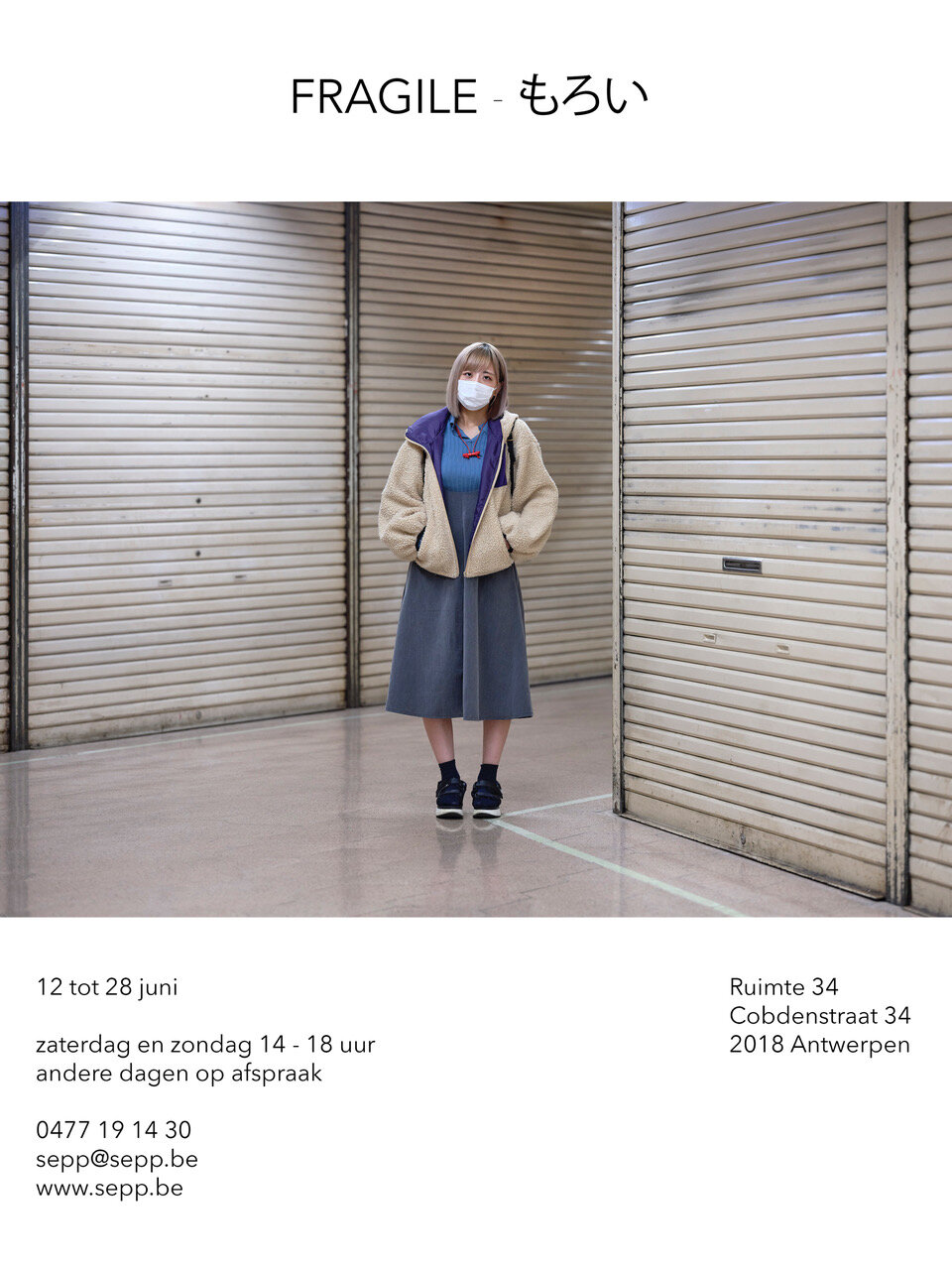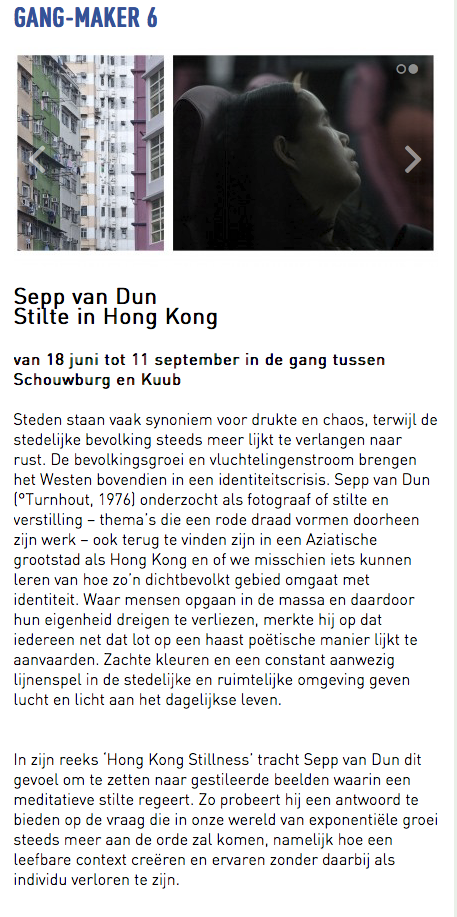Fragile - もろい
In april 2019 reisde ik een eerste keer naar Tokio. Ik wilde mijn zoektocht naar verstilling in een Aziatische metropool, die ik aanvatte in 2016 in Hong Kong, verderzetten. De fascinatie voor de Japanner als individu en zijn omgang met anderen kreeg me echter in zijn greep. De manier waarop hij zich een weg zoekt in de stad maar vooral in zijn sociale omgeving met al haar eigenaardigheden, trok mijn blik. Mijn statief bleef aan de kant, de architectuur tegen blauwe luchten sprak mij minder aan. Meer en meer zocht ik de avond en de schemering. De reis bleek te kort.
Bij mijn thuiskomst botste ik op ontstellende feiten. Ruim één miljoen Japanners sluit zichzelf op om alle sociale contacten te vermijden en houdt dat zes maanden tot tien jaar vol. Meer dan 40% van de Japanse bevolking is single. Japan heeft het laagste geboortecijfer ter wereld. Veel Japanse jongeren hebben geen zin meer in seks. Intimiteit in de brede zin van het woord, is te koop in alle maten en kleuren.
In november 2019 bezocht ik Tokio een tweede maal, met mijn focus op verbondenheid, intimiteit en sociaal contact. Afstand houden, ‘social distancing’ zoals we dat ondertussen kennen, is er eerder regel dan uitzondering. Het is alsof de Japanse samenleving doordrongen is van een existentiële eenzaamheid, die wij als Westerling graag ontkennen. Ondertussen hebben we begrepen dat afstand houden het collectieve belang dient, en kunnen we ons afvragen of het net de ondergeschiktheid aan de gemeenschap is die de Japanse samenleving ademt.
Met mijn fotografische impressie ‘Fragile - もろい' neem ik u graag mee in hoe ik Tokio beleefde.
—————
More than one million Japanese lock themselves up to avoid all social contacts. More than 40% of the Japanese population is single. Japan has the lowest birth rate in the world. Many Japanese young people no longer feel like having sex. Intimacy in the broad sense of the word is available in all sizes and colours.
In 2019 I visited Tokyo for two longer periods, with my focus on connection, intimacy and social contact. Keeping distance, 'social distancing' as we in the West know it now after the covid pandemic, is the rule rather than the exception. It is as if Japanese society is permeated with an existential loneliness, which we as Westerners like to deny. Meanwhile, we have understood that keeping our distance serves the collective interest, and we can ask ourselves whether it is the subordination to the community that breathes Japanese society.
Hong Kong Stillness
‘Hong Kong Stillness’ is a photographic series that explores themes of introspection and silence in an Asian city undergoing significant social, political, urban, and cultural transitions.
Cities are synonymous with bustle and chaos. Population growth and the influx of refugees has created a giant identity crises for the inhabitants of European cities. To cope with the situation requires a significant reversal in the mindset of individuals and a genuinely global outlook. The pace of change is staggering and with that comes new challenges.
Hong Kong has long since embraced this future but how do the city’s inhabitants, the hundreds of millions of people who call it home, create a livable context? If stillness and silence can be found in Hong Kong, what might we in the West learn from such a densely populated metropolis about how to cope with massive transitions? In places where people feel that they are being swallowed up by the crowd and fear they will lose their identities, this project proposes stillness as a vital source of knowledge.
In 2015 I created a small series of color photographs depicting people and structures in Hong Kong in various states of stillness, capturing the quieter moments of transition in the daily life of the city’s inhabitants. I noticed that people seemed to accept the transitions in their frenetic urban lives in an almost poetic way. Employing soft colors and drawing on the city’s pattern of ever-present lines, I translated this observation into stylized images that evoke an atmosphere of air and light, and in which silence reigns. What remains when the hustle and bustle of Hong Kong dies down, when the city transitions from a state of intense activity to a state of stillness, is silence.
My proposed project for the WMA Commission is to capture Hong Kong’s population, and the city in which they live, at moments of transition in their daily lives. As a Belgian photographer living in Antwerp, an urban context that is undergoing huge transitions, ‘Hong Kong Stillness’ is a celebration of a diverse Asian metropolis and a response to the questions and challenges facing cities in the West.
Curated by Natasha Becker, independent curator, NY
Submitted as a project about Transition at WMA Commission HK
Selected by ddk-live.com to pitch at De Donkere Kamer Antwerp
Shortlisted by Nikonians Photography Awards 2017
Expo's
Obumex, Antwerp Art Weekend, 20 May - 17 June 2016
Gang-Maker cc De Warande, Turnhout, 19 juni - 11 september 2016
Geuzenhuis, Gent, duo exposition with Geert Huysman ('Il était une fois'), 06 - 14 oktober 2016
MKKPT, Borgerhout, December - January 2016
La Roumanie, douze points - Romenia, twelve points
In 2007 trad Roemenië toe tot de Europese Unie. Na tien jaar van lichte vooruitgang gaat het intussen opnieuw de verkeerde kant op met het meest corrupte land van Europa. Door recente justitiële hervormingen wordt het onvermogen om corruptie te bestrijden alsmaar groter.
In maart 2017 maakte ik de balans op via een roadtrip doorheen Centraal Roemenië. Het werd een avontuur zoals ik het me had voorgesteld. Wantrouwen vormde de rode draad doorheen mijn trip.
In mijn reeks "Romania twelve points, la Roumanie douze points" wil ik een sfeerbeeld scheppen van een land waar werk aan is. Maar Europa kan dat.
Waar mijn vorige reeks over verstilling in Aziatische grootsteden een eerder poëtisch beeld schept op en een ruimere interpretatie toelaat van een globale maatschappij, beoogt ‘La Roumanie, douze points’ het omgekeerde. Door een rechttoe rechtaan manier van fotograferen wil ik via ruwere beelden de realiteit weergeven van de concrete toestand in Roemenië.
Silentium
Peter Van Heirseele: “Het is een oud verhaal, de strijd van schilderkunst met fotografie. Als kunstschilder dacht ik lang dat - in deze tijd van digitale media - de fotografie gedoemd was te verdwijnen. Sepp van Dun bewijst met zijn analoge middenformaatcamera het tegendeel. Met grafisch sterke beelden in sobere kleuren wekt hij weemoed op. Tijdloze plaatsen nodigen uit om te blijven kijken. Schilderkunst komt steeds dichterbij. De fotografie is gebleven, er wordt nog altijd geschreven met licht.”
Expo's
- MKKPT, Borgerhout, May - Juin 2014
- Loft Living, Nieuwpoort, November 2014 - July 2015




